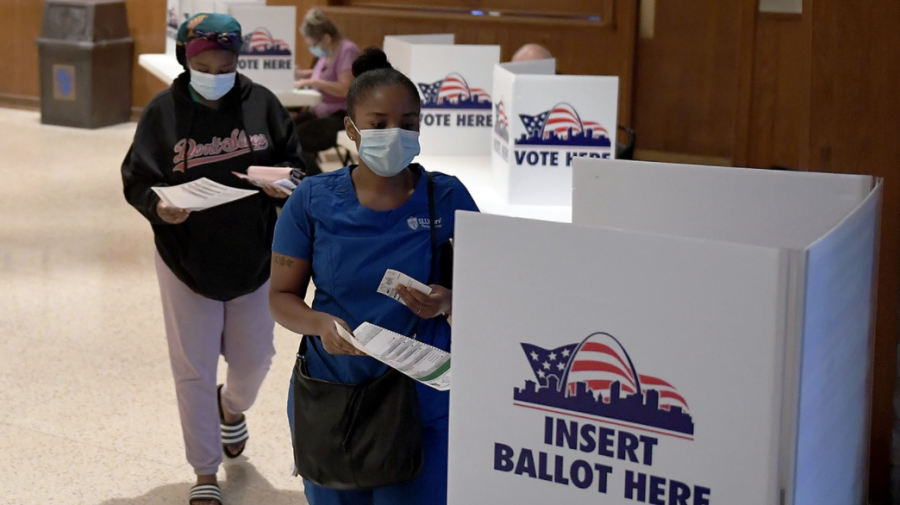The relevance of voter suppression in 2020
People continue to cast their ballots in-person during the primary election despite the pandemic.
November 22, 2020
Although the 2020 presidential election began back on Nov. 3, several states are continuing to count votes. The election was full of unauthorized ballot drop boxes, errors in counting votes and questionable ballots from those who are deceased or moved to a different region, according to CBS News. Perhaps it is this chaos along with the ongoing pandemic that is preventing people from seeing the relevance and continuation of voter suppression in 2020.
In the American education system, children are often taught that with great power comes great responsibility and that democracy grants sovereign power to the people. American citizens are obliged to follow the law, pay taxes and serve on a jury, yet in the last couple of decades, an uncountable number of Americans have been denied the right to vote. Whether the cause is a lack of ballots near their homes, transportation or the intentional efforts of politicians to manipulate the votes, voter suppression remains very relevant today.
Voter suppression dates back to 1870 when the 15th Amendment of the United States Constitution was ratified, allowing all citizens to vote despite one’s race or color. However, this amendment was not properly enforced, as Blacks and other people of color were still discriminated against when trying to vote. There were restrictions such as the grandfather clause, literacy tests and poll taxes among others that prevented groups of people from voicing their opinions in the government. This eventually led to the Voting Rights Act of 1965 that prohibited racial discrimination in voting. In 2013, the Supreme Court ruled that Sections 4(b) and 5 of the Voting Rights Act were unconstitutional in Shelby County v. Holder. Section 5 required certain state or local governments with a history of discrimination to submit proposed changes to their voting laws to the federal government before they went into effect. And Section 4(b) explained the requirements for the jurisdictions mentioned in Section 5. Because of this ruling, states were able to implement voter identification laws that had been previously blocked and redistrict maps without federal approval.
So here in 2020, more than fifty years after this legislation was passed, many American citizens are still unable to vote. A simple yet detrimental cause for this is because election day is on a Tuesday when most people have to work. According to Pew Research, in the 2016 presidential election, about 2.7 million people selected “being too busy or having a conflicting schedule” for why they were unable to vote, making this option the third-highest reason.
Some people do not wish to vote, but for those who do want to uphold their civic duty of voting, it is highly problematic that there are policies or lack thereof that physically prevent people from voting and changing the value or worth of each vote.
Voter identification is when the voter must bring a government-issued photo ID in order to cast a vote. According to Business Insider, 34 states required an ID for this election. Additionally, there are many specific policies that need to be followed in order to be registered and be eligible to vote. According to the American Civil Liberties Union (ACLU), Kansas advocated for a law requiring people to show documents proving their citizenship, such as passports or birth certificates, preventing 30,000 people from voting. Additionally, New York requires voters to register at least 25 days before the election, a restriction that prevented 90,000 New Yorkers from voting in the 2016 presidential election. Proponents argue that voter identification provides safeguards against fraud. However, according to the Washington Post, between 2000 and 2014, there were only 31 allegations of voter impersonation. Taking into account that one billion ballots were casted during this time period, fraud is highly unlikely, and the issue of fraud is not statistically significant enough to influence voter turnout. And after the 2020 presidential election, “election officials in dozens of states representing both political parties said that there was no evidence that fraud or other irregularities played a role in the outcome of the presidential race,” Nick Corasaniti, Reid J. Epstein and Jim Rutenberg wrote in The New York Times.
Another common reason people are unable to vote is due to voter purges. The election administration is responsible for removing voters who died, moved or are ineligible to vote to update records. “But a minority of states go further and engage in a practice that ought to be seen as glaringly unconstitutional—purging people from the rolls solely because they have skipped voting in several consecutive elections and they have not responded to a letter asking them to confirm where they live,” Paul Smith wrote on the American Bar Association website.
These people are often informed about their voting status on the day of the election or without adequate notice. According to the Brennan Center for Justice, almost 16 million voters were purged from the rolls between 2014 and 2016.
There are also problems such as gerrymandering, which is when the party in power redraws district borders to manipulate the results of the data. Depending on how the population district lines are drawn, a certain party may win even with the same data of votes. “Maryland stands out as a prime example of Democratic gerrymandering. In 2016, Republicans won 37% of the statewide House popular vote, which translated into just one of the state’s eight House seats,” Christopher Ingraham wrote in the Washington Post.
Although all voters can be impacted by voter suppression, whether this is intentional or not, there are often certain groups of people targeted. The restrictions explained above are oftentimes enforced more heavily on certain individuals. Based on data from Project Vote, people of color, lower-income individuals and younger voters had a lower likelihood of having a government-issued ID.
People with disabilities are restricted as well since not all polling locations accommodate those with disabilities. Additionally, according to the ACLU, 70% of voters purged in Georgia in 2018 were Black, which is clearly disproportionate to the ratio of Blacks who live in Georgia compared to other races. The racial bias in the criminal justice system also contributes to voter suppression because a felony conviction can lead to a suspension or loss of one’s right to vote. As Blacks often deal with harsher punishments compared to their white counterparts, a greater number of Blacks are impacted by felony disenfranchisement.
Under the Constitution, voting is a fundamental right that must be protected by the government for every citizen over the age of 18 years old. But it is also important that voters are aware of their own rights and the regulations restricting those rights.
Voter suppression is still a prominent issue for many. In response to voter suppression, individuals can read through the policies and laws before going to the booth to vote. People can also begin political campaigns to prevent voter suppression or get involved in organizations such as the Brennan Center for Justice or the ACLU in order to spread awareness about voter suppression in the 2020s.

























































